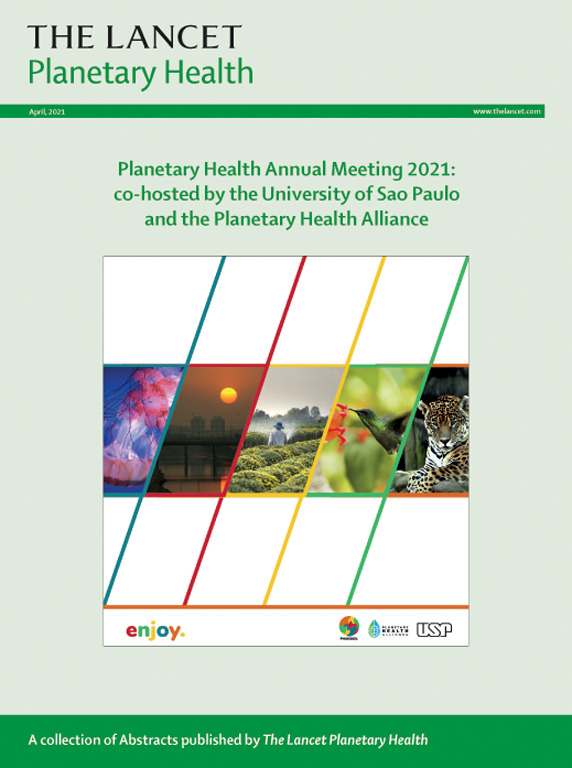The mortality and associated economic burden of London's summer urban heat island effect: a modelling study
IF 24.1
1区 医学
Q1 ENVIRONMENTAL SCIENCES
引用次数: 0
Abstract
Background
High ambient temperatures lead to increased mortality, especially in older adults. Climate change will increase the frequency and severity of heatwaves globally. Most of the UK population lives in urban areas, which often have higher temperatures than rural areas (the urban heat island [UHI] effect) and higher rates of heat-related mortality. We estimated the mortality burden in terms of attributable mortality and years of life lost (YLLs), and social costs attributed to the UHI effect in summer 2018 in Greater London.
Methods
We estimated the UHI effect using advanced urban climate modelling. We applied a quantitative health impact assessment to estimate mortality and YLLs attributable to high air temperature. We estimated social costs using value of statistical life (VSL) and value of statistical life-years (VOLY) methods.
Findings
We attribute 785 (95% CI 655–919) deaths in summer 2018 in Greater London to high air temperature. Half of these (399 [350–446]) are attributable to the UHI effect, or approximately 5·0 (4·1–5·9) thousand YLLs. Social costs of the summer UHI effect due to mortality are estimated at £987 million (866 million–1·10 billion) using VSL or £453 million (367–533 million) using VOLY (2023 prices).
Interpretation
Monetised costs attributed to the UHI effect remain high using either VSL or VOLY approaches. The findings demonstrate the seriousness of heat as a public health risk, set a scale at which society may be willing to pay for urban heat mitigation, and give tangible support for large-scale urban heat mitigation and adaptation policies.
Funding
Wellcome Trust.
伦敦夏季城市热岛效应的死亡率和相关经济负担:一个模型研究
环境高温导致死亡率增加,尤其是老年人。气候变化将增加全球热浪的频率和严重程度。大多数英国人生活在城市地区,那里的气温通常比农村地区高(城市热岛效应),与热有关的死亡率也更高。我们估计了2018年夏季大伦敦地区可归因死亡率和生命损失年数(YLLs)的死亡率负担,以及归因于UHI效应的社会成本。方法利用先进的城市气候模型对城市热岛效应进行估算。我们应用定量健康影响评估来估计高温导致的死亡率和YLLs。我们使用统计生命值(VSL)和统计生命年值(VOLY)方法估计社会成本。我们将2018年夏季大伦敦地区785例(95% CI 655-919)死亡归因于高温。其中一半(399[350-446])可归因于热岛效应,或约5.5万(1.4 - 5.9万)个yll。由于死亡率造成的夏季热岛效应的社会成本估计为使用VSL的9.87亿英镑(8.66亿- 1.1亿英镑)或使用VOLY的4.53亿英镑(3.67 - 5.33亿英镑)(2023年价格)。解释使用VSL或VOLY方法,UHI效应带来的货币化成本仍然很高。研究结果表明,热量作为一种公共健康风险的严重性,设定了一个社会可能愿意为城市热量缓解买单的规模,并为大规模城市热量缓解和适应政策提供了切实的支持。FundingWellcome信任。
本文章由计算机程序翻译,如有差异,请以英文原文为准。
求助全文
约1分钟内获得全文
求助全文
来源期刊

Lancet Planetary Health
Multiple-
CiteScore
28.40
自引率
2.30%
发文量
272
审稿时长
8 weeks
期刊介绍:
The Lancet Planetary Health is a gold Open Access journal dedicated to investigating and addressing the multifaceted determinants of healthy human civilizations and their impact on natural systems. Positioned as a key player in sustainable development, the journal covers a broad, interdisciplinary scope, encompassing areas such as poverty, nutrition, gender equity, water and sanitation, energy, economic growth, industrialization, inequality, urbanization, human consumption and production, climate change, ocean health, land use, peace, and justice.
With a commitment to publishing high-quality research, comment, and correspondence, it aims to be the leading journal for sustainable development in the face of unprecedented dangers and threats.
 求助内容:
求助内容: 应助结果提醒方式:
应助结果提醒方式:


